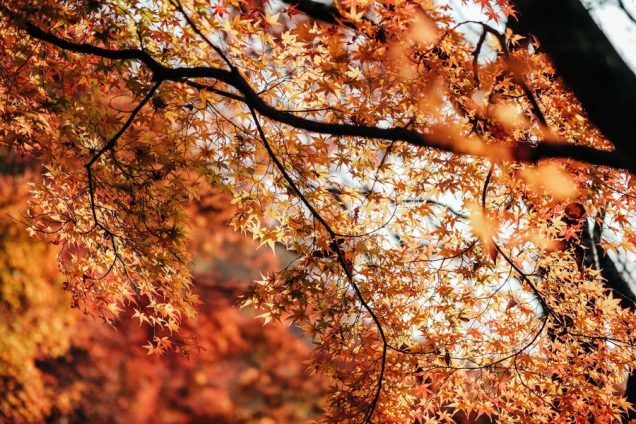Fall has arrived in New England, and that means a very literal demonstration of the season’s name: the annual time of leaves falling. Here in Connecticut, we get to enjoy a stunning display of autumn foliage throughout the coming months.
But even as we marvel at the seasonal beauty, we must think about some of the implications those yellow, red, and brown leaves can have, once they yield to gravity and wind.
Fallen leaves can impact water quality, which is something both municipalities and private well owners need to think about. And as your go-to well water business in Connecticut, we’re here to help!
How Fallen Autumn Leaves Can Affect Water Quality
The decaying process of leaves releases nutrients that were produced and accumulated in a tree’s foliage throughout the growing season. This release helps fertilize the soil, and it’s a normal and important part of the nutrient cycle in forest and woodland environments. A tree’s fallen leaves directly serve to nourish it, although some trees also extract and recycle nutrients from leaves in the fall before they drop.
However, the nutrient release from leaf decomposition can cause issues with water quality. We often see this when trees are in concentrated areas, and especially when the leaves are flushed directly into streams, rivers, and lakes. Spikes in nitrogen, phosphorus, and other plant nutrients can result in eutrophication (excessive nutrient inputs into aquatic ecosystems) and harmful algal blooms, which can lower oxygen levels and release toxins.
These contaminants are a big issue in urban and suburban environments where autumn leaves fall or where they’re raked onto impervious surfaces, such as driveways and streets. The leaves then usually wash into storm drains or culverts, which affects well owners. Heavy loads of phosphorus and other nutrients from leaf decomposition can enter groundwater around a well (not to mention surface water, which could impact an inadequately sealed or damaged well).
Normal drainage ways clogged by thick pile ups of fallen leaves can also cause localized flooding, which is another potential source of water contamination.
Avoiding Water-Quality Issues With Fallen Leaves This Fall
Proactively managing the falling leaves is key to minimizing impacts to local watersheds and your own drinking water.
Rake up and remove leaves that fall within a close radius of your wellhead. Fallen leaves can be disposed of or utilized in several ways. If you have a yard-waste pickup service, take advantage of that. You can also create compost piles far from your well, or spread out your property’s leaf litter as mulch for garden beds or plants.
Don’t let these leaves accumulate on driveways, sidewalks, streets, and other paved surfaces, where run-off can transfer them directly into the local drainage systems.
Be on the lookout for any small-scale flooding that might result from poor drainage created by layers of fallen leaves.
Inspecting Your Wellhead
This time of year is ideal for ensuring your wellhead is in good condition and properly fitted. After all, summertime lawn care can result in accidental damage to a wellhead, and coming winter snows and frigid temperatures can complicate assessments later in the season. A cracked or improperly sealed wellhead may allow surface water loaded with decaying leaf contaminants to get into your well water supply.
It’s essential to have your entire well system inspected by a professional service at least once a year. Here at Greco & Haines, we offer such checkups all year-round — along with, of course, the ability to repair or replace wellheads and fulfill other essential maintenance needs, such as well water pump upkeep and yield tests.
Well Water Pump & Water Filtration Systems From Greco & Haines
Another way to protect your household well water from excessive nutrients and other contamination is with a full-home (aka point-of-entry) water filtration system. We provide a wide array of top-quality water filters and softeners, including reverse-osmosis, ultraviolet, and activated-carbon technologies and multimedia filtration setups.
Greco & Haines Well Water Water Quality Testing
Besides implementing well inspections and repairs and installing state-of-the-art full-home water filtration systems, we also offer our customers comprehensive water-quality testing services. Our water-quality tests can help screen for chemical and nutrient imbalances or the presence of microbes and contaminants.
Get in Touch With Greco & Haines for Autumn Well Service
We’re here for you anywhere in Connecticut, seven days a week and 365 days a year. Mark the fall season with a well inspection, water-quality testing, and any maintenance or repairs you’ve put off. Get in touch with the Greco & Haines team at 203-735-9308, 203-777-2256, or 1-800-922-2958 (toll-free from any Connecticut area code). Reach out to us via the Greco & Haines website and we’ll be in touch by the next business day.
In the meantime, enjoy those spectacular New England fall colors! And don’t forget to explore other articles here at the Greco & Haines Learning Center, where you can learn more about how wells work, how to repair a well pump, and all sorts of other subjects.

